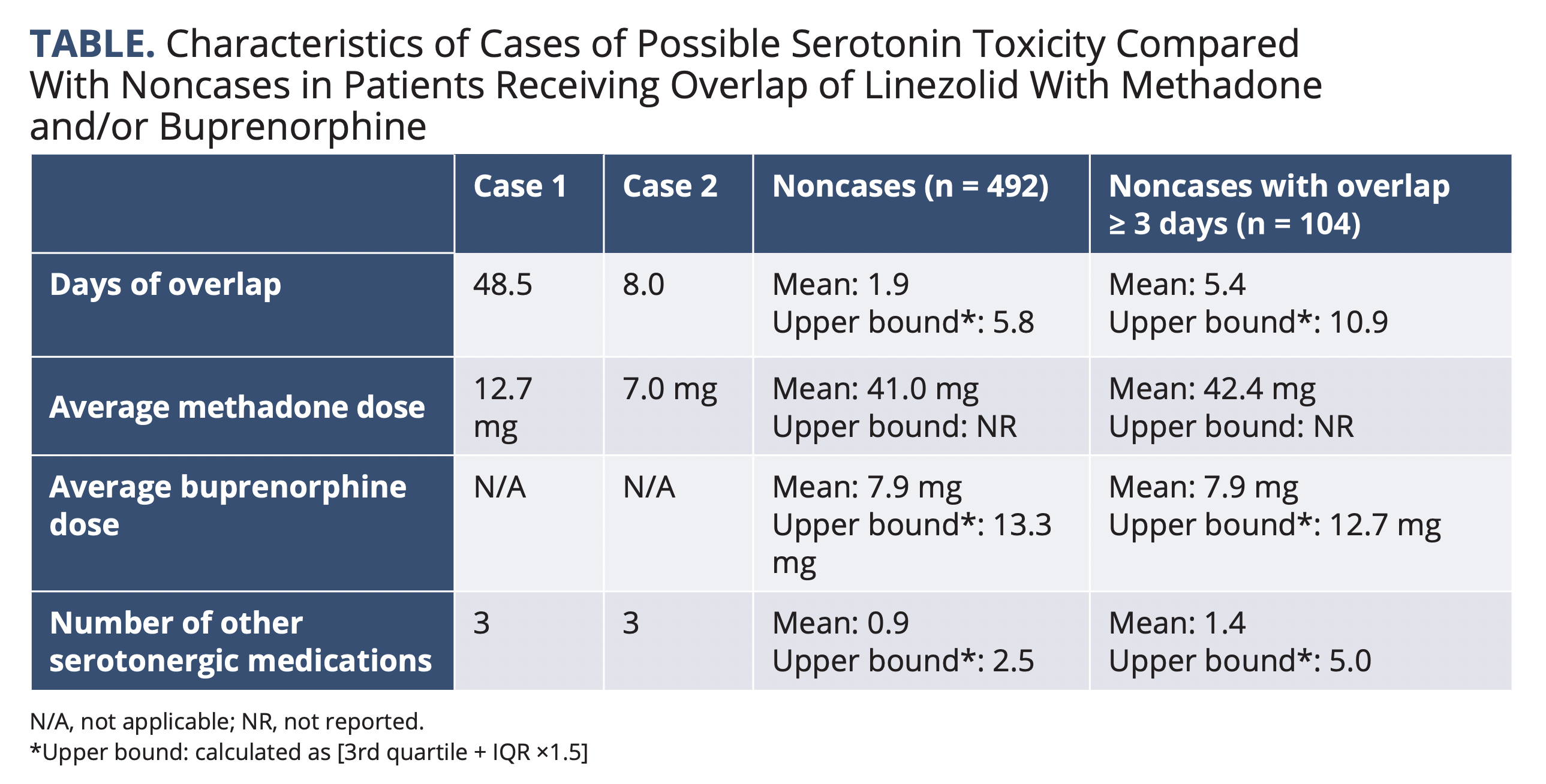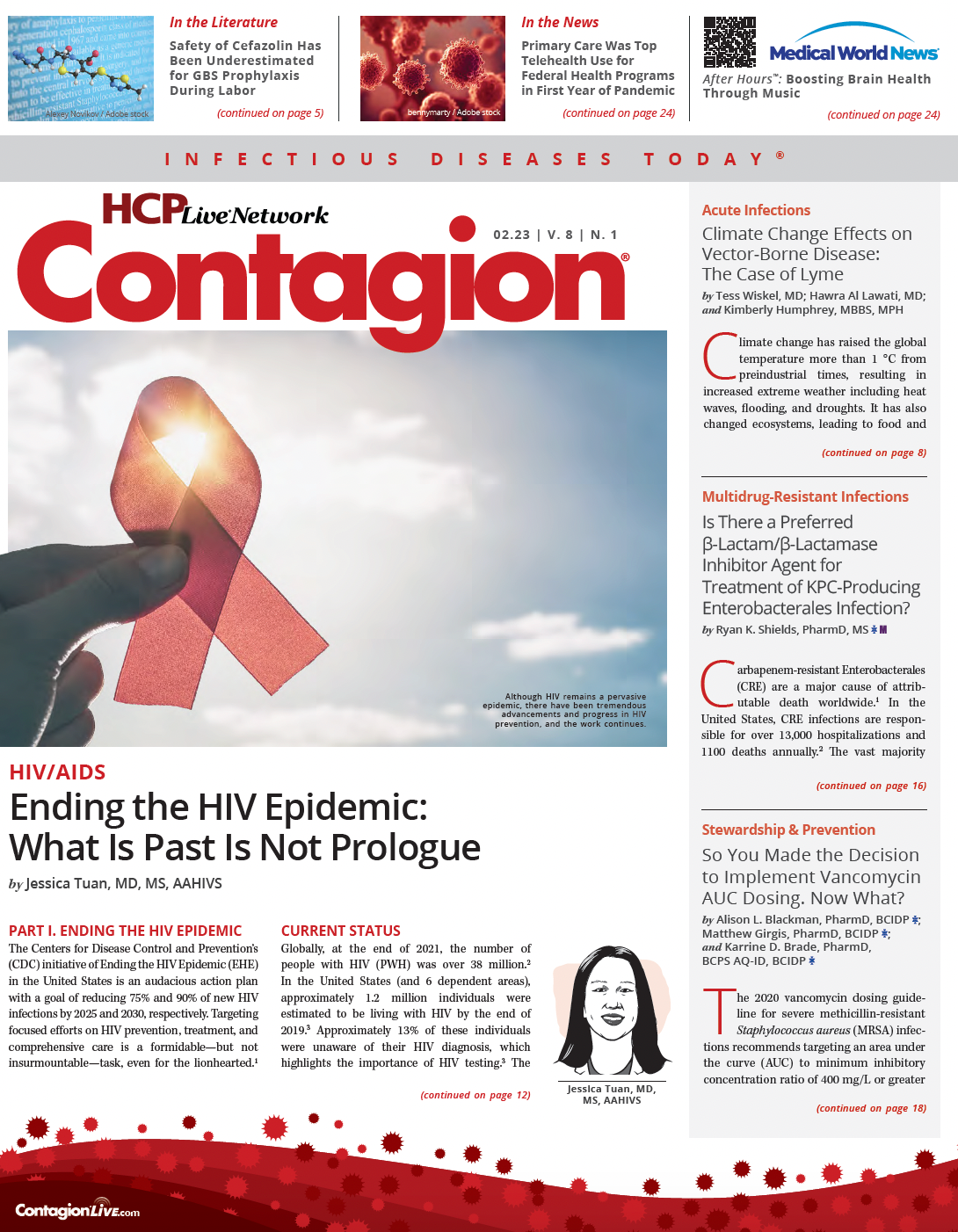Linezolid Coadministration With Medications for Opioid Use Disorder: A Serotonin Toxicity Tightrope?
This study characterized the incidence of serotonin syndrome and identified contributing risk factors with combined medications for opioid use disorder (MOUD) and linezolid use.
Linezolid is an oxazolidinone antibiotic with activity against gram-positive bacteria including methicillin-resistant Staphylococcus aureus (MRSA) and vancomycin-resistant Enterococcus. Its pharmacokinetic advantages include virtually 100% oral bioavailability and wide tissue distribution.1 However, use may be limited by adverse effects including myelosuppression, peripheral neuropathy, lactic acidosis, and serotonin syndrome.2
As a nonselective monoamine oxidase inhibitor, linezolid has the potential to precipitate serotonin syndrome, a severe condition characterized by altered mental status, autonomic dysfunction, and neuromuscular excitation.3 Although package labeling and FDA recommendations support discontinuation of concomitant serotonergic medications before the initiation of linezolid,2,4 clinical practice is varied.
Persons who inject drugs (PWID) may be at risk for serotonergic drug interactions if they are receiving medications for opioid use disorder (MOUD), specifically methadone and buprenorphine. In vitro pharmacokinetic data and retrospective reports suggest methadone is a likely serotonergic agent with a low to intermediate risk for serotonin syndrome due to its high lipophilicity and large tissue distribution.5,6 In contrast, there appears to be limited association between serotonin syndrome and buprenorphine.5,6
Traver et al conducted a single-center retrospective cross-sectional analysis to characterize the incidence of serotonin syndrome and identify contributing risk factors with combined MOUD and linezolid use. The study included hospitalized adult patients who received linezolid within 24 hours of buprenorphine and/ or methadone. Cases with documented concern for serotonin toxicity in the medical record were independently adjudicated by 2 physicians and classified as “noncases,” “possible” cases, or “definite” cases of serotonin syndrome.
The Hunter criteria, an established diagnostic method for serotonin syndrome, was applied retrospectively to possible and definite cases. Outcomes included the average doses of MOUDs administered, duration of concurrent administration of linezolid and MOUD, and the number of additional serotonergic agents. The IQR method of outlier detection was applied to compare cases with noncases.
The study included 494 unique encounters comprising 383 unique patients, with an average hospital admission length of 15.7 days. Zero definite cases and 2 possible cases of serotonin syndrome were identified (0.40% of encounters; upper 1-sided 95% CI, 0.87%). Both possible cases were part of the prolonged overlap subgroup (> 3 days; 1.89% of subgroup encounters; 1-sided 95% CI, 4.06%), and both involved the use of methadone with linezolid for long periods (Table).

In case 1, a patient receiving linezolid, methadone, and trazodone developed tachycardia, hyperreflexia, and ankle clonus. Of note, methadone was discontinued 7 days before onset of potential toxicity, and symptoms resolved after the discontinuation of trazodone. In case 2, a patient receiving linezolid, methadone, and bupropion experienced encephalopathy and tremor, which resolved following discontinuation of linezolid and methadone.
Limitations of this study include the analysis of only inpatient data; linezolid is often used as an oral therapy in the outpatient setting and further information about longer-term outpatient use is warranted. Additionally, diagnosis of serotonin syndrome relied on clinician identification and documentation, which can be challenging in the absence of a prospective diagnostic protocol.7 Consistent with previous literature, the described incidence of serotonin toxicity with linezolid and methadone is low, particularly when coadministered for durations less than 3 days, supporting the safety of temporary linezolid use such as when a patient loses intravenous access. The risk may be increased with a longer duration of overlap and an increased number of additional serotonergic agents. The dose of methadone did not appear to correlate; however, further research is needed. Buprenorphine continues to demonstrate an even lower risk. MRSA infections in patients with opioid use disorder may involve complications such as endocarditis and osteomyelitis, necessitating several weeks of antibiotic therapy.8 Although increasing literature demonstrates the success and safety of outpatient parenteral antimicrobial therapy in select PWID, oral antibiotics remain an important option for many patients.9 Recently, organizations including the American Heart Association have highlighted the importance of an interdisciplinary approach to the treatment of infectious diseases in patients with opioid use disorder, including the prioritization of MOUD and harm reduction strategies.10 The findings from this study add to our understanding of the risks associated with linezolid and further the dialogue of optimizing antimicrobial therapy in this patient population.
References
- Dryden MS. Linezolid pharmacokinetics and pharmacodynamics in clinical treatment. J Antimicrob Chemother. 2011;66(suppl 4):iv7-iv15. doi:10.1093/jac/dkr072
- Zyvox. Prescribing information. Pharmacia & Upjohn Co; 2021.
- Simon LV, Keenaghan M. Serotonin Syndrome. In: StatPearls [Internet]. StatPearls Publishing; 2022 Jan–.
- FDA drug safety communication: serious CNS reactions possible when linezolid (Zyvox) is given to patients taking certain psychiatric medications. Updated December 14, 2017. https://www.fda.gov/drugs/drug-safety-and-availability/fda-drug-safety-communication-serious-cns-reactions-possible-when-linezolid-zyvox-given-patients
- Baldo BA, Rose MA. The anaesthetist, opioid analgesic drugs, and serotonin toxicity: a mechanistic and clinical review. Br J Anaesth. 2020;124(1):44-62. doi:10.1016/j.bja.2019.08.010.
- Gatti M, Raschi E, De Ponti F. Serotonin syndrome by drug interactions with linezolid: clues from pharmacovigilance-pharmacokinetic/pharmacodynamic analysis. Eur J Clin Pharmacol. 2021;77(2):233-239. doi:10.1007/s00228-020-02990-1
- Prakash S, Rathore C, Rana KK, Dave A, Joshi H, Patel J. Refining the clinical features of serotonin syndrome: a prospective observational study of 45 patients. Ann Indian Acad Neurol. 2019;22(1):52-60. doi:10.4103/aian.AIAN_344_18
- Jackson KA, Bohm MK, Brooks JT, et al. Invasive methicillin-resistant Staphylococcus aureus infections among persons who inject drugs — six sites, 2005-2016. MMWR Morb Mortal Wkly Rep. 2018;67(22):625-628. doi:10.15585/mmwr.mm6722a2
- Cortes-Penfield N, Cawcutt K, Alexander BT, Karre VMM, Balasanova AA. A proposal for addiction and infectious diseases specialist collaboration to improve care for patients with opioid use disorder and injection drug use-associated infective endocarditis. J Addict Med. 2022;16(4):392-395. doi:10.1097/ADM.0000000000000936
- Baddour LM, Weimer MB, Wurcel AG, et al. Management of infective endocarditis in people who inject drugs: a scientific statement from the American Heart Association. Circulation. 2022;146(14):e187-e201. doi:10.1161/CIR.0000000000001090

